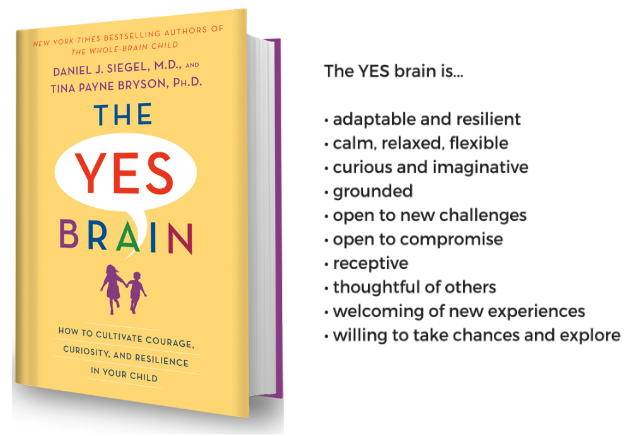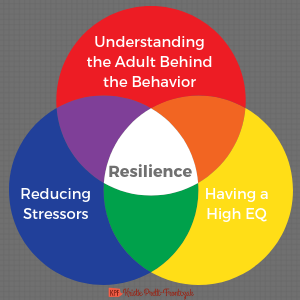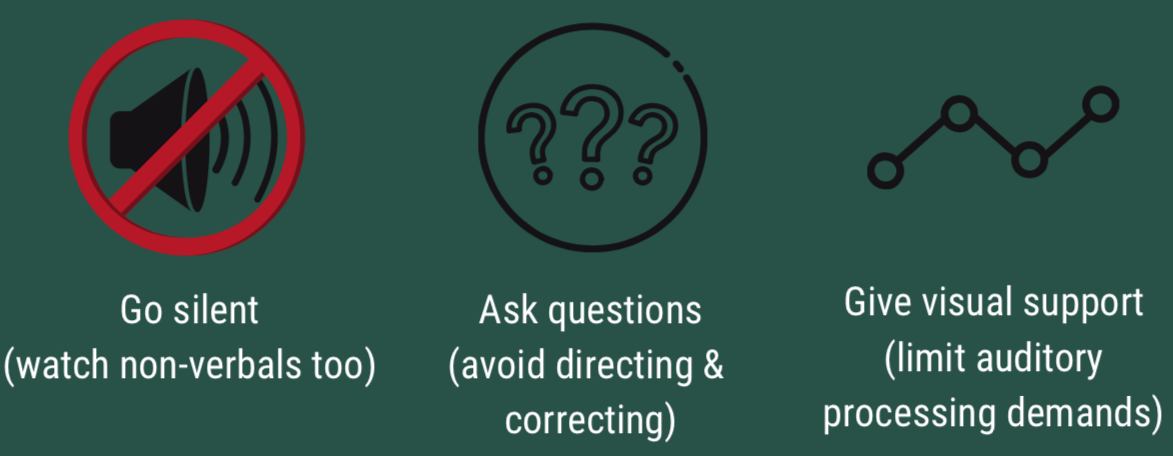You may know my mantra…”Mindset before Methods“, which means before we think about which practices to hold onto, which to adapt, and which to shed, we need to address our core values, beliefs, and attitudes.
But what if your mindset is operating from a “No Brain” perspective?
What if the mindset of your staff is reactive, rigid, and dripping with resistance?
In this post, I share the top three things successful leaders do to move from resistance to resilience.
Resilience – the capacity to shift from reactivity to receptivity and come back to balance (Dan Siegel and Tina Payne Bryson)
We start by understanding a few things about the brain…and in particular, how to foster a “Yes Brain” perspective and cultivate “Yes Brain” behaviors.
In their book, “The Yes Brain: How to Cultivate Courage, Curiosity, and Resilience in Your Child“, Drs. Dan Siegel and Tina Payne Bryson end each chapter talking about how like children, the adult brain can work from two places…a “Yes Brain” perspective or a “No Brain” perspective.
 The “Yes Brain” is “able to find joy and meaning”…is open to compromise, receptive to new experiences, and responds in a calm, relaxed, and flexible ways. The “No Brain” on the other hand, is “unable to make good decisions, or connect and care of others.”
The “Yes Brain” is “able to find joy and meaning”…is open to compromise, receptive to new experiences, and responds in a calm, relaxed, and flexible ways. The “No Brain” on the other hand, is “unable to make good decisions, or connect and care of others.”
Which brain do you want for those who are working with young children? Which brain do you want for leaders of the ECE {R}evolution?
For me…I know we need adult professionals and leaders that work from a “Yes Brain” perspective.
But is it possible to move staff from a “No Brain” to a “Yes Brain”?
The great new is…YES!
Here are three things you can do right now!
1) Understand What Drives Behavior
In our blog, “Why Even Coaching Can’t Get To A Change In Behavior” Laura Fish and I talk about how leaders need to understand that behind all behaviors, there is a person. That behaviors are just a representation of what is going on “inside” that person. And when we take our focus off the behavior and place it squarely on figuring out the need that is driving the behavior, we make headway. When we understand the need, we can chart a course to help the adult professionals (and/or children) find more appropriate ways to respond to situations and challenges.
Here is a list of common human needs, which when unmet…result in “No Brain” behaviors:
- Autonomy
- Belonging
- Certainty
- Comfort
- Connection
- Contribution
- Growth
- Independence
- Love
- Mastery
- Respect
- Safety (physical and emotional)
- Satisfaction
- Significance
Before you roll your eyes thinking about your most resistant staff member…review the list of needs one more time.
Then think about typical coaching sessions, staff evaluation measures, and even the agenda from your last professional development day. Would you say that what was expressed with words and through your actions created a sense of belonging, showed staff that their work matters, or affirmed that you are a campion for their success?
Or, would you say that as you think about coaching sessions, evaluation measures, or staff meetings, more time is spent talking about compliance and rules, running through all the reasons why something won’t work, or trying to change their behaviors by telling them what they should be doing?
Successful leaders are committed to seeing adults wholistically…to help adults develop the self-awareness and behaviors that are appropriate for getting their needs met.
As you consider this first strategy, don’t misunderstand, it’s not for you to try and fix adults or to take on the responsibility for ensuring their needs are met 24/7/365. Rather…successful leaders remain curious (even when they feel like cursing) and look behind the behavior to identify which needs aren’t being met.
Leaders create a culture with built-in opportunities to meet the needs of diverse groups of adults.
Take Away Message!
To move from resistance to resilience, successful leaders pay attention to the needs of the adult professional more than their behaviors.
Here’s an Action Step!
Next time you are faced with resistance, activate the parasympathetic nervous system and stimulate Positive Emotional Attractors (PEAs). Here are a couple of things you can do:
- Ask your staff questions like, “What’s working right now?”, “Can you tell me about a time when you felt the best about your work?”, or “What is your wish for the rest of the year?”
- Ask yourself,” In this situation, what can I do to model deep listening instead of wanting to fix or judge?” or “Am I “attuned” with my staff and making an effort to understand their perspective?”
2) Understand The Role Of Stressors
When I first read “Self-Reg: How to Help Your Child (and You) Break the Stress Cycle and Successfully Engage with Life” by Stuart Shanker, I was blown away. I had never thought of stress in such broad terms…one that covers five domains, and I hadn’t considered the role stress plays in resistance and other “No Brain” behaviors.
Walter Bradford Cannon and Hans Selye, defined “stress” as anything that disturbs the functioning of the systems that keep our body and mind running smoothly. These systems range from maintaining an average body temperature of 98.6 or regulating the amount of sodium and glucose in our bloodstream to managing our emotions or our interpersonal relationships. Click to read full article.
Common stressors many staff are exposed to:
- Inadequate sleep
- Too much screen time
- Caffeine
- Doubtfulness
- Negative conversations
- Time pressures
- Too many interruptions
- Fitting in to other cultural norms
- Hostility
- Moral dilemas
- Unfairness
And these are just a few of the many things that cause our bodies stress and result in “No Brain” behaviors like resistance.
Take Away Message!
To move from resistance to resilience, successful leaders know the impact of stressors and do what they can do reduce them.
Here’s an Action Step!
Next time you are faced with resistance, try one of these 12 things to help reduce stressors for the adults you are working with.
Click here to listen to an excerpt from one of my Deep Dive Master classes on Teaching Adults To Get Results, where I provide an example of how to reduce stressors with an adult professional who challenges you.
3) Understand How To Raise Your EQ
Increasingly, we’ve come to understand the important role emotional intelligence plays across contexts, disciplines, and the lifespan.
Emotional intelligence is the ability to identify and manage your own emotions and the emotions of others. It is generally said to include three skills: emotional awareness; the ability to harness emotions and apply them to tasks like thinking and problem solving; and the ability to manage emotions, which includes regulating your own emotions and cheering up or calming down other people. Psychology Today
Leaders with strong emotional intelligence:
- Build trusting relationships
- Engage authentically with others
- Create a connection with others
- Demonstrate an overall positive tone
- Resonate energy and enthusiasm
Take Away Message!
To move from resistance to resilience, successful leaders raise their emotional intelligence and design and deliver professional development that helps staff raise their EQ too.
Here’s an Action Step!
Take my EQ quiz for ECE Leaders and then learn how you can raise your EQ from any of the resources:
- Why even great leaders struggle to achieve change
- Managing Change Is Even More Complex Than You Thought
- ECE Leaders Need A High EQ! Is Yours High Enough?
- Guiding Questions That Will Raise Your EQ And Transform PD
- Reflect upon the “Contrasting Emotions Chart” [jpg] from Emotional Intelligence by Mayra Porrata and Crystal Pirri – free gift e-copy [pdf] or buy the book here.
- Learn more about emotional intelligence [blog] [pdf]

